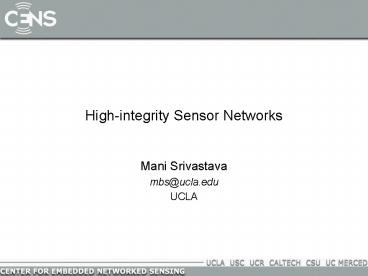Highintegrity Sensor Networks PowerPoint PPT Presentation
1 / 11
Title: Highintegrity Sensor Networks
1
High-integrity Sensor Networks
- Mani Srivastava
- mbs_at_ucla.edu
- UCLA
2
High Integrity Sensor Networks
Information returned may be distorted
NEW FOCUS
Malicious attack (privacy, denial ofservice,
corruption)
- Noise random error, unavoidable
- In the sensor
- In communication
Fault Persistent,transient,intermittent
malfunction
Hard to counterEasy to learn
Easy to counterHard to learn
3
Key Issues and Challenges
- Sensor nodes have to be cheap
- Fault-tolerant, secure hardware not feasible
- Unmanned and untethered
- No central supervision
- Severe resource constraints
- Limited memory, CPU, b/w
- Scale
- Collaborative behavior
- Decentralized in-networkprocessing for energy
efficiency - Open wireless medium
Handle misbehaving nodes
Existing solutions not portable
End-to-End Model?
Robust Relaying
4
Spectrum of Integrity Problems
Misbehaving Node
Misbehavior while routing event
report Well-studied ad hoc routing problems
5
Spectrum of Integrity Problems
It was a false alarm.No such car!
Misbehaving Node
Misbehavior during in-network processing (e.g.
generation of bad event, suppression of event)
Well-studied fault tolerant computing problems
6
Spectrum of Integrity Problems
No car Detected
Misbehavior during information generation (e.g.
miscalibrated or compromised sensors)
No car Detected
Our focus!
7
Approach Reputation-based Framework
Key Question How do nodes trust each other?
8
Basic Concept - Learning from Experience
Watchdog mechanism
Reputation
Trust
Behavior
Second hand information
- Observe the action of other nodes Watchdog
mechanism - Develop a perception of other nodes over time
Reputation - Predict their future behavior Trust
- Cooperate/Non-cooperate with trustworthy nodes
Behavior - Share experiences to facilitate community growth
Second hand info
9
Skeleton Structure of RFSN
Watchdog mechanism
Reputation
Trust
Behavior
Second hand information
Algorithm Development Monitoring, Data
Analysis Statistics.
Networking,Cryptography
Decision theory Bayesian Analysis
10
Bayesian Formulation of Sensor Integrity
- Reputation representation for neighbors as beta
distribution - two parameters (cooperation, non-cooperation)
- Easy to compute reputation updates and
integration using belief theory - Updates
- Integration
- Reputation propagation via public key crypto for
node authentication - Trust to estimate future cooperative behavior q
of node j with reputation Beta(aj, bj) - Classifying node behavior as good/bad by simple
threshold on trust
New reputation, ??
Old reputation, Beta(aj, bj)
????
11
Conclusions
- Reputation-based approach is
- Scalable localized algorithms
- General communication, sensing, processing
- Unified faulty, malicious, noisy
- But insufficient for certain malicious attacks on
integrity - Context-aware adversaries
- Resource consumption attacks
- Compromises of the physical world
Network level techniques? Multimodality?
No Event
No Event

